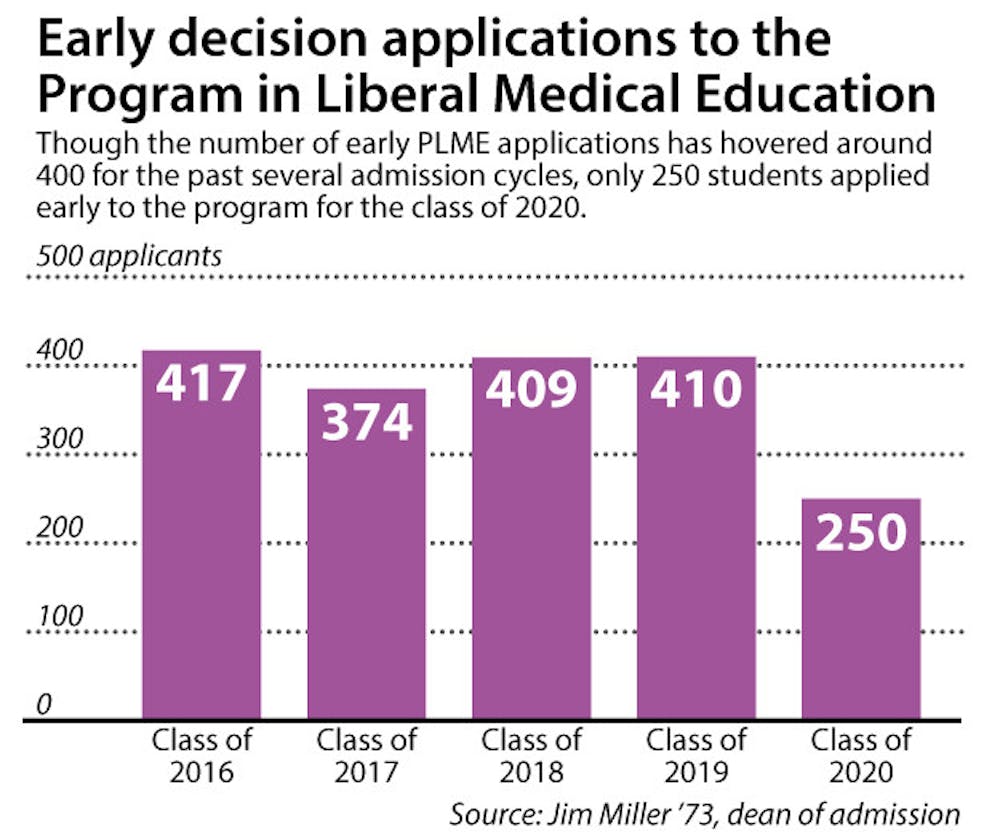Early decision applications to Brown’s Program in Liberal Medical Education dropped from 410 last year to 250 for the class of 2020, said Dean of Admission Jim Miller ’73. The drop was expected, given a change in the early decision policy for PLME applicants, he said.
The PLME applicants join a total early application pool of about 3,000 students, Miller said, though he declined to disclose the exact number.
In previous admission cycles, early decision PLME applicants could decide if they wanted to be considered for binding early admission to the College if they were not admitted to PLME. But under the new policy, applicants no longer have this decision: Those who are not admitted to PLME but are admitted to the College are required to attend the College, according to the Office of Admission’s website.
The policy was changed to simplify the early decision application because “a number of applicants were confused about the option and were not sure what they were committing to,” Miller wrote in an email to The Herald. He added that while the drop in early applications was anticipated, the University expects the number of PLME applicants to increase in the regular decision pool.
The size of this year’s overall early applicant pool remained fairly constant from previous admission cycles, Miller said. Last year, the University saw the second largest early decision pool in its history at 3,016 students. The year before, the University received a record-high 3,088 early applications.
If this year’s regular decision pool remains on trend with previous years, the overall pool will likely be similar to last year’s 30,397 applicants. “Early decision represents about 10 percent of our overall applicants,” Miller said.
This year’s application was slightly shorter than that of previous years, as applicants had to write fewer supplements, he said.
Miller estimated that 170 athletes applied early decision this year — a number consistent with previous years, he said.
Fifty-eight students applied to the Brown/RISD Dual Degree Program. Though this number is similar to last year’s 59, it marks an almost 25 percent drop from the 77 applications received for the class of 2018.
Applicants hailing from abroad make up 16 percent of the applicant pool. The highest numbers of international applicants came from China, Korea, India, the United Kingdom and Singapore, in that order.
Applicants from the South, Midwest, Mountain states and Central states make up 13, 8, 2 and 1 percent of the applicant pool, respectively. Twenty percent of applicants come from New England, and 14 percent are from California.
Miller said the most popular intended concentrations — biology, engineering, international relations and business, entrepreneurship and organizations — remained consistent with last year’s. Across the four main concentration areas, 28 percent of applicants noted an intent to concentrate in social sciences, 24 percent in life and medical sciences, 22 percent in physical sciences and 18 percent in humanities. Eight percent are undecided, down from last year’s 16 percent.
The Admission Office will begin reviewing applications around Thanksgiving, Miller said. Decisions will likely be sent out during the second week of December.
Early applicants constituted 38 percent of the class of 2019 — the lowest percentage of the Ivies that have a binding early decision policy. The percentages for Columbia, Cornell, Dartmouth and Penn were 45, 41, 43 and 54 respectively. Harvard, Princeton and Yale have non-binding early action policies.
Ashvini Melkote, a high school senior from West Hartford, Connecticut, who applied early, said she was attracted to Brown by the open curriculum. “I want to do neuroscience, but I also want to have a really good liberal arts experience,” she said, adding that the open curriculum would allow her to personalize her education.
Brittany Stinson, of Wilmington, Delaware, also said the open curriculum would allow her to “take academic risks,” adding, “As cheesy as it sounds, while I was doing research, I felt that I could really see myself there.”
Fei Han Xie, a student from China who is currently attending high school in Washington D.C., said he chose to apply early to Brown because of its applied mathematics program. Xie said that while other schools teach only traditional, formulaic math, Brown’s applied mathematics is “pragmatic” and emphasizes the “real world applications” of the subject.
Xie recalled visiting Brown and seeing Dean of the College Maud Mandel handing out snacks to students on the Main Green. “At Brown, they are really welcoming,” he said.





